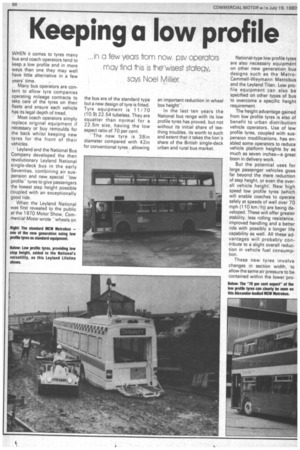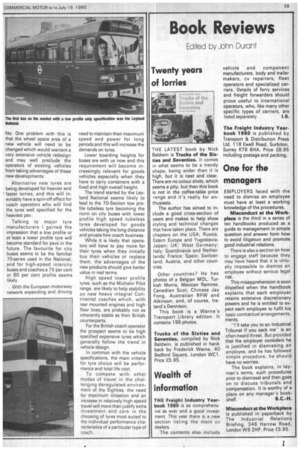Keeping a low profile
Page 60

Page 61

If you've noticed an error in this article please click here to report it so we can fix it.
.,.in a few years from now. psv operators May find this is the wisest stategy, says Noel
WHEN it comes to tyres many bus and coach operators tend to keep a low profile and in more ways than one they may well have little alternative in a few years' time.
Many bus operators are content to allow tyre companies operating mileage contracts to take care of the tyres on their fleets and ensure each vehicle has its legal depth of tread.
Most coach operators simply replace original equipment if necessary or buy remoulds for the back whilst keeping new tyres for the front of their vehicles.
Leyland and the National Bus Company developed the then revolutionary Leyland National single-deck bus in the early Seventies, combining air suspension and new special "low profile' tyres to give passengers the lowest step height possible coupled with an exceptionally good ride.
When the Leyland National was first revealed to the public at the 1970 Motor Show, Commercial Motor wrote -wheels on
the bus are of the standard type but a new design of tyre is fitted, Tyre equipment is 11 / 70 (10.9) 22.54 tubeless. They are squatter than normal for a 22.5m size, having the low aspect ratio of 70 per cent.
"The new tyre is 38in diameter compared with 42in for conventional tyres , allowing an important reduction in wheel box height".
In the last ten years the National bus range with its low profile tyres has proved, but not without its initial share of teething troubles, its worth to such and extent that it takes the lion's share of the British single-deck urban and rural bus market. National-type low profile tyres are also necessary equipment on other new generation bus designs such as the MetroCammell-Weymann Metrobus and the Leyland Titan. Low profile equipment can also be specified on other types of bus to overcome a specific height requirement.
The height advantage gained from low profile tyres is also of benefit to urban distribution vehicle operators. Use of low profile tyres, coupled with suspension modifications, has enabled some operators to reduce vehicle platform heights by as much as seven inches—a great boon in delivery work.
But the potential uses for large passenger vehicles goes far beyond the mere reduction of step height, or even the overall vehicle height. New high speed low profile tyres (which will enable coaches to operate safely at speeds of well over 70 mph (110 km /h)) are being developed. These will offer greater stability, less rolling resistance, improved handling and a better ride with possibly a longer life capability as well. All these advantages will probably contribute to a slight overall reduction in vehicle fuel consumption.
These new tyres involve changes in section width, to allow the same air pressure to be contained within the lower pro file. One problem with this is that the wheel space area of a new vehicle will need to be changed which would warrant a very extensive vehicle redesign and may well preclude the operators of existing vehicles from taking advantages of these new developments.
Alternative new tyres are being developed for heavier and ' faster lorries, and this will inevitably have a spin-off effect for coach operators who will find the tyres well specified for the heaviest psv.
Talking to major tyre manufacturers I gained the impression that a low profile or at least a lower profile tyre will become standard for psvs in the future. The favourite for city buses seems to be the familiar 70-series used in the National, and for high-speed intercity buses and coaches a 75 per cent or 80 per cent profile seems likely With the European motorway network expanding and driving need to maintain their maximum speed and power for long periods and this will increase the demands on tyres.
Lower boarding heights for buses are with us now and this requirement will become increasingly relevant for goods vehicles especially when they have to carry containers with a fixed and high overall height.
The trend started by the Leyland National seems likely to lead to the 70-Section low profile tubeless tyre becoming the norm on city buses with lower profile high speed tubeless tyres developed for goods vehicles taking the long distance and private hire coach business.
While it is likely that operators will have to pay more for their tyres when they initially buy their vehicles or replace them, the advantages of the new products should give better value in real terms.
High speed lower profile tyres, such as the Michelin Pilot range, are likely to help stability on new heavy integral Continental coaches which, with rear mounted engines and high floor lines, are probably not as inherently stable as their British counterparts.
For the British coach operator the prospect seems to be high specified expensive tyres which generally follow the trend in vehicle design.
In common with the vehicle specifications, the main criteria for tyre choice will be performance and total life cost.
To compete with other modes of travel in the challenging deregulated environment of the Eighties, the need for maximum itilisation and an increase in relatively high speed travel will more than justify extra investment and care in the choosing of tyres most suited to the individual performance characteristics of a particular type of coach.








































































































































